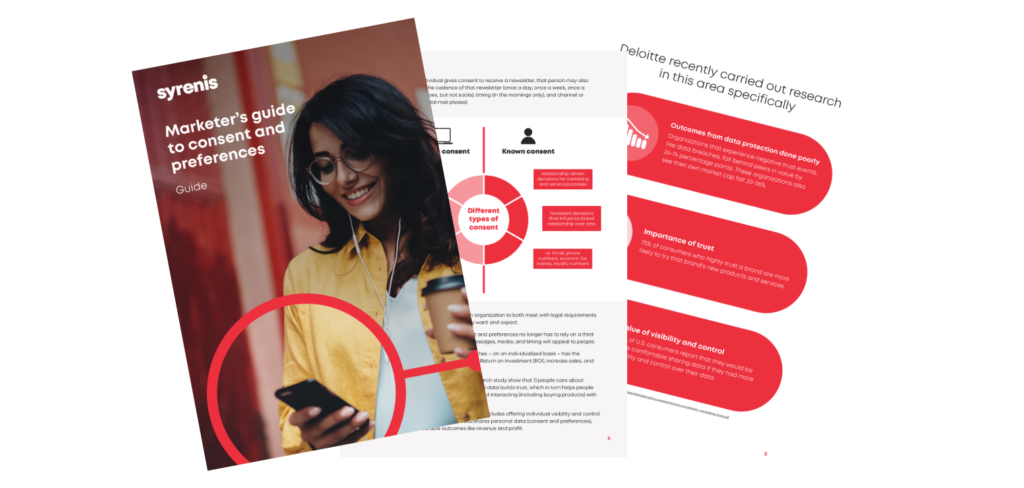Personalization – changing online experiences, communications, and more according to customer needs rather than only presenting generic experiences or content – is a non-negotiable in today’s marketing world.
But a recent report by Braze found that a staggering 99% of marketers said that their plans to personalize campaigns had been has been impacted by data privacy concerns. That’s a whole lot of missed opportunities because of complex legislation that can make it difficult to know if you’ve truly got the okay to hit send on a campaign.
As the report highlights, marketers need to know exactly what customers have agreed to share. It’s a fine balance between privacy and personalization, making sure that there’s genuine value in the experiences created through sharing more data. Unsurprisingly, enterprise brands are most concerned about this, possibly because they know they’ll be at risk of higher fines and scrutiny from regulators.
It’s well known that audiences want more – 71% of customers expect personalization and 90% find it appealing. However, the meaning of “personalization” has changed dramatically in recent years.
Previously, “personalization” meant changing content and communications based on educated guesses based on third-party data and segmentation. That is, marketers placed individuals into broad categories, or segments based on demographic information (e.g., age, gender, income, ethnicity, marital status), geography, psychographic factors (e.g., lifestyle), and/or behaviors (e.g., online shopping or surfing activities).
Marketers had to rely on third-party data to determine into which segment they should place an individual. Then, marketers had to make another educated guess about what content, products, communication channels, and communication frequencies would appeal to each segment and deliver accordingly.
As the marketplace has moved from brick-and-mortar stores to the online world, and as web technologies like cookies and other trackers have developed, Big Data has given marketers more data with which to work. In some cases, more data has resulted in improved accuracy of marketing predictions. However, there are still significant challenges to the practices of segmentation-based personalization and marketing.
The challenges of personalization
Even data-driven segmentation is an assumption, not a fact
In fact, marketers must make two guesses during segmentation. First, marketers must estimate into which group to place an individual, usually based on third-party data that may or may not be accurate or timely. Second, marketers must then make conjectures about which products, services, and communications will appeal to individuals in each segment.
Segmentation often involves handling sensitive information
Though not all segmentation efforts involve sensitive data, some of the more accurate methods require demographic information, such as race/ethnicity, religion, family status, and even health information. Increasingly, privacy laws restrict sensitive information processing for marketing purposes.
Some privacy laws, such as the upcoming United States Maryland privacy law, prohibit use and sharing of sensitive information for these purposes, regardless of any gathered consents. Data breaches of sensitive information will typically trigger notification requirements, which are costly and have the potential to damage brand and attract regulator attention.
The future of third-party data through cookies/online trackers is doubtful
The trajectory for third-party cookie data is uneven but on a downward trend. Many jurisdictions require organizations to provide at least an opt out and sometimes an opt-in mechanism through which consumers can express a choice for third-party advertising cookies. Cookie consent rates vary widely across all websites, with key factors such as opt-out/opt-in model and experience design influencing consent rates.
That said, regardless of whether 80% of users implicitly agree or 20% explicitly agree, in all cases websites lose the opportunity to collect and share at least some user data. Companies are also finding closer regulatory attention to the cookie consent design experience. For example, Honda recently ran afoul of the United States Federal Trade Commission for online cookie consent banner experiences.
Moreover, browsers have long been on a journey to deprecate third-party cookies altogether. Safari and Firefox have eliminated third-party cookies, resulting in approximately 50% of internet traffic being without these types of trackers. Google’s back-and-forth on third-party cookies has been less straightforward, and the latest announcement on that topic reveals an important and highly criticized step back by Google on that front. However, the reality is that privacy concerns have significantly reduced the amount of third-party cookie data available now, with possibly even less available in the future.
Segmentation done well can be, well… Creepy
Ironically, when segmentation is highly accurate it can turn people away rather than attract them. People who receive a marketing communication or customized online experience that is exactly ‘right on,’ can feel spied on and avoid interacting with the organization altogether.
For example, if an individual who has not interacted with an online health food store previously but sees an experience that exactly matches previous web searches for hair loss prevention vitamins and offers free delivery to the city in which they live, that individual reasonably feels watched and leaves the website, never to return.
Building trust through transparency
Consent-based personalization
The alternative to segmentation-based personalization is consent-based personalization. Made possible by Artificial Intelligence (AI) and consent management technologies, consent-based personalization allows an organization to gather first-party information from consumers directly and accommodate in customized communications, online experiences, and products or services.
The benefits of consent-based personalization are the flip side of the above problems with segmentation and third-party data-based personalization. Since consent-based personalization involves asking each person what they want, like, and need, there are no more guesses involved. It is not only an accurate process, but since consumers have on-going control and can make changes as their needs change, the process also allows for timeliness.
There are no more third-party cookie or data problems. In most cases, organizations do not have to collect sensitive information either. For example, instead of collecting race/ethnicity information to get at preferences and interests indirectly, the organization just directly asks the individual about their preferences and interests – without race/ethnicity in the equation at all. The consumer can answer or not, and if they answer they know exactly how the company received its information, and the ‘creepy factor’ goes away.
Customers know exactly how their data is being used and marketers know exactly how they can use it.
As in most business activities, there are challenges to consent-based personalization as well. In a word, complexity is the reason that previous customization techniques relied instead on segmentation and third-party data. Specifically, at scale, it is incredibly complex to manage consents and preferences, multiplied not only across a large customer base but also across jurisdictions and time. However, technological advancements – including AI – have made this burden possible through sophisticated consent management platforms.
Now, organizations can easily manage multiple consent experiences across different geographies and channels. Consent management platforms also allow organizations to operationalize consents and preferences through integrations with multiple systems and types of data. With the sophistication of today’s AI, organizations can then take real-time action on consents and preferences to customize experiences and communications on an individualized basis. In-platform capabilities can also help gather preferences in an organic way – through pop ups, for example, at the right time, to increase relevancy and conversion.
Though consent-based personalization requires technology and planning to effectively manage, the results are well worth it. In addition to avoiding the pitfalls of segmentation and third-party data-based customization, consent/preference-based personalization has the potential to increase sales, profits, and brand attachment.


